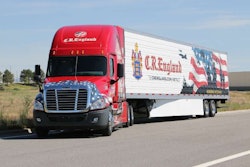 Liquid Trucking Human Resources Director Jason Eisenman is joined by Load One CEO John Elliot and Paper Transport Vice President Ben Schill at CCJ Spring Symposium Wednesday.
Liquid Trucking Human Resources Director Jason Eisenman is joined by Load One CEO John Elliot and Paper Transport Vice President Ben Schill at CCJ Spring Symposium Wednesday.Communication is powerful but isn’t always easy between drivers and co-workers who may be thousands of miles apart or seldom see one another.
A panel assembled at the CCJ Spring Symposium Wednesday, May 7 in Birmingham, Ala., discussed how technology has enabled richer and more meaningful levels of information sharing and improved the driver experience.
Liquid Trucking Human Resources Director Jason Eisenman notes that when drivers retire – he says the average age at his carrier is 52 years old – they take all their institutional knowledge with them.
In 2014, management identified a communications gap with drivers and partnered with Stay Metrics to implement Driver Satisfaction Surveys.
A year later the carrier debuted DeliveRecon, an app that allows drivers to share knowledge – including wash and parking locations and tips about receivers – with 200 editable fields, creating a simple hub for drivers to communicate and access everything from one place. Essentially, Eisenman says the app was designed to capture and redistribute all the information that previously walked out the door with the driver.
“We’re letting the drivers essentially train one another,” he says.
Drivers earn points through the platform for sharing tips or uploading information, which can include anything from directions to a facility, photos of the receiver or off-loading tips.
Since debuting the platform and implementing some of the feedback from driver surveys, Eisenman says Liquid Trucking has seen a 46 percent drop in accident/incident reduction, a 24 percent increase in weekly average truck revenue and after four years since implementing the app, turnover has dropped from 68 percent to 24 percent.
Helping drivers find freight
As an expedited transportation and freight management provider, Load One starts the day with only roughly 20 percent of that day’s freight booked. About 80 percent of orders from customers have immediate service requirements, which Load One CEO John Elliot says complicates the company’s growth strategy.
To help attract drivers to a hauler that gets the bulk of its freight on the fly, Elliott says the carrier developed a solution that put drivers in greater control of securing loads for themselves.
Load One Ultimate Advantage Driver App is a mapping tool that provides Load One drivers with historical and real-time information on demand and capacity, allowing them to determine where to optimally position themselves to pickup a hot load, reduce wait time and increase both productivity and earnings.
The additional layers of business insight, Elliott says, has also become a retention tool.
“Once you give these guys information, it’s power,” Elliott says. “Knowledge is power.”
Extending training
Paper Transport Vice President Ben Schill sought an open platform that blended the technology used in the back office with the tech in the cab of the truck, and could consolidate some of the random various tech the company drivers were using.
Paper Transport deployed an open-source Galaxy tablet that allowed the company to funnel data to the drivers that was traditionally only available to management.
The tablets have given drivers a portable well of information but also allowed them to extend training. As a result, turnover from 0 to 90 days has plummeted.
“We’ve actually extended our orientation by deploying different videos through their tenure,” he says. “Having real-time learning throughout, that’s been a significant thing for us.”
Frustrated by lack of available trip planning options that didn’t account for driver’s Hours of Service the carrier developed its own. The company traditionally on-boarded new drivers by coupling them with trainers. Part of that training includes trip-planning tips but it can take years to hone that expertise.
With the its new technology, Paper Transport shaved the trip planning learning curve to a simple push of a button that lets drivers see a simulated trip plan on a digital map that shows them where and when they will arrive at customers, fuel stops along the route and mandated rest break locations.
A separate driver scorecard app reviews daily performance across several categories and allows drivers to see where they rank and track their progress toward a monthly reward.












